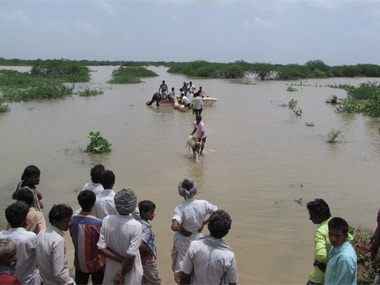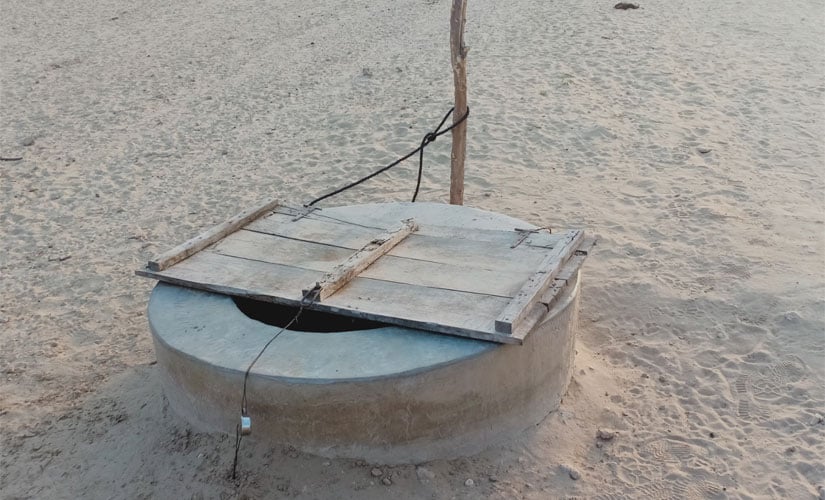Editor’s note: Rajasthan’s relationship with summer is not a pleasant one. The shortage of water in the region only adds to the misery of the people. Even before the onset of summer, over 5,000 villages in nine districts in Rajasthan — Barmer, Churu, Pali, Bikaner, Jaisalmer, Jalore, Jodhpur, Hanumangarh and Nagaur were declared ‘drought-affected’ by the state government. The drought in this area affects the economy of the region as employment options dry up and people start migrating to neighbouring states like Gujarat to survive. This five-part series will examine the reasons and problems related to one of the worst drought conditions in the region. This is the first-part of the series.
***
Barmer: Barmer district in Rajasthan is evidence of alarming changes in ecological indicators across the Thar desert. While total rainfall received in the region has registered an increase, its uneven distribution during monsoon season has affected crops putting farmers in distress. In 2017, Sheo-Kawas and Dhorimanna-Gudamalani belt of Barmer district received 245 mm rainfall just in last week of July which caused flood-like conditions in many parts of the district, but the state government same year had to declare 1,900 out of 2,775 villages of the district ‘drought-affected’. [caption id=“attachment_6309111” align=“alignleft” width=“380”]  While many areas reeled under a drought-like condition, some areas in the district had to face a flood-like situation in July last year. Mukesh Mathrani/101Reporters[/caption] With agriculture and cattle rearing being the only means of livelihood for locals of Thar desert, persistent drought has forced residents to migrate to other regions within the state while many others continue to cope with cascading effects of drought, which hampers agricultural production, results in shortage of drinking water and fodder, and affects both, human and animal health. Crop loss and low purchasing power have pushed the region into poverty. Of the total cultivated 15,73,029 hectare land in 2016, crops on 10,95,230 hectare were destroyed due to the failure of monsoon. While the losses were not as bad in 2017—crop loss of 6,88,095 hectare of the total cultivated 15,50,213 hectare in 2018—saw a severe drought as crops grown on 12,61,513 hectare were lost of the total cultivated 15,18,190 hectare area. The rural population of Barmer depend on the government to provide relief during times of drought whose inefficient management of relief efforts pushes them towards the common practice of seasonal migration. Erratic rainfall This strange phenomenon where the district has registered an increase in average rainfall over the years but also had to face drought almost every year in the last decade has posed a challenge in this largely rainfed agricultural region. While the average rainfall of the district was 275 mm in the last 10 years, it is 343 mm at present. Of the total geographical area of 28,17,332 hectare, 18,63,365 hectare in Barmer is cultivable area. Of the total cultivable area, about 80 percent is rainfed region while rest is irrigated. Among the irrigated land, 5.15 percent area is irrigated with canal water while 31.09 percent is irrigated with open wells and remaining 63.73 percent using tube wells. Pradeep Pagariya, a scientist at Krishi Vigyan Kendra in Barmer, says the region has been receiving more rainfall since past few years, but across a shorter period. Away from the normal monsoon of four months, the region now receives rainfall only for two months, which could even be limited to only a month at times.
Barmer in 2017 received 95 mm rainfall in June and 245 mm in July, but only 18 mm in August and saw no rain in September. Some parts of the district, approximately 208 villages of Dhorimanna, Gudamalani, Sindhary, Balotra and parts of Sheo tehsil received excess rainfall and faced flood situation, which also affected the crops. The district administration takes into account the crop assessment report to declare a district ‘drought-hit’.
Overexploitation of groundwater Western Rajasthan, which encompasses Jalor, Barmer, Jaisalmer, Jodhpur and Bikaner districts, comes under an arid zone that has a high temperature, low humidity, low rainfall, erratic and poor textured soils. Agriculture system in this region is mostly rain-fed, mono-crop and of subsistence type because of climatic constraints. Water scarcity is a serious problem in the region with good rainfall expected only in an interval of three to four years. Rainfall data of the last 100 years shows the region has dealt with famines in 61 seasons, of which 24 were severe famines, while the rest were medium. A recent report of Central Arid Zone Research Institute (CAZRI) claims the Thar desert has been witnessing major climatic changes over past decades. According to the report, Thar witnessed about 17 thunderstorms annually in 1966, which has now reduced up to 2.5 per year. The trend of shifting sand dunes has also affected weather patterns. These conditions have led the farmers of Barmer to look towards other sources of irrigation for their crops. With easy access to pumping instruments, groundwater is being drafted at an alarming rate. Approximately 2,000 tube wells have been dug in this region and high dependency on groundwater has resulted in its over-exploitation, says Pagariya. [caption id=“attachment_6309171” align=“alignnone” width=“825”]  A locked well in Barmer is a testimony to the serious water crisis in the situation. Mukesh Mathrani/101Reporters[/caption] Barmer was declared ‘over exploited’ region in the Ground Water Assessment Report 2013 prepared by Central Ground Water Department, which revealed the overdraft at 123.85 percent per annum. Six out of total eight blocks were categorised as ‘over exploited’ while one was declared ‘critical’. Baitu block in the district, with 226 percent overdraft, was notified as ‘Dark Zone’. Another alarm in the report was that while the district’s groundwater recharge rate was 278.01 million cubic metre, the consumption rate was 312.14 million cubic metre. The groundwater level in the district has been declining at a rate of 5-6m each decade, according to the report. Government’s fault: Foreign flora AK Changani, Head, Department of Environment at MGS University, Bikaner says, “Extraction of groundwater has increased. Population density is increasing. Local flora and fauna are shrinking because of the uncontrolled growth of weeds and shrubs. Sand dunes are now covered with layers of Prosopis Julifolra (Vilayati Babool). This affects the natural phenomenon of sandstorm and rainfall distribution.” In this region, groundwater is available at three to four hundred feet deep. Due to which earlier people could not able to get the water for agricultural purpose. But with advanced technology, people are now able to access deep groundwater. As a consequence of it, there is a sharp increase in tube wells. Pagariya says that changes in groundwater table and an increase in average rainfall and irrigated area have together increased the humidity in the region. He claims that the humidity in the region was around 10 percent two decades ago but has jumped to 35 percent at present. The government initiatives, like the Desert Development Programme (DPP) launched around two decades ago to control desertification and adverse effects of drought, have only added to climate woes, according to experts. Sand dunes accounted for 54 percent area of the state in 1990, which has now come down to 48 percent. Pagariya blames this ecological imbalance on plantation of foreign flora species, such as the Israeli Tortilis by the forest department in order to stabilise the sand dunes while ignoring traditional native species such as Khejri (Prosopis Cineraria), Jaal (Salvadora Persica), Kummat (Acacia Senegal), Gunda (Cardio Mixa) and Rohida (Ticumula Undulata). While arguing that the varieties planted by forest department were not conducive to the ecology of the region, Pagariya vies for dense plantation and other sand dune stabilisation methods that haven’t been explored. Environmentalist Bhuvnesh Jain says traditional plants are familiar with the desert ecology being natural species of the region. Tampering with nature results in punishment, says Jain, adding that traditional plant species not only balance the climate cycle in the desert region but also support the rural economy by providing a source of additional income to rural Indians since decades. The author is Barmer-based freelance writer and a member of 101Reporters.com.


)

)
)
)
)
)
)
)
)



